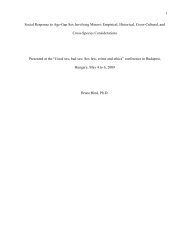Infant and Child Sexuality: A Sociological Perspective - Ipce
Infant and Child Sexuality: A Sociological Perspective - Ipce
Infant and Child Sexuality: A Sociological Perspective - Ipce
Create successful ePaper yourself
Turn your PDF publications into a flip-book with our unique Google optimized e-Paper software.
The new data which the study supplies comes from several sources.<br />
From over one thous<strong>and</strong> sex histories—recall—that I have collected from<br />
college students while teaching courses in human sexuality <strong>and</strong> marriage<br />
<strong>and</strong> the family, from interviews with two hundred unwed mothers<br />
receiving case work services through a large private child-care agency<br />
in the Upper Midwest, <strong>and</strong> from case material obtained in six communities<br />
where we observed <strong>and</strong> interviewed around the general question,<br />
What is it like to grow up (sexually) in ________ community? Four of<br />
the communities were in the Upper Midwest—two rural, one inner city,<br />
<strong>and</strong> one suburban. The other two communities were in the urban industrial<br />
Northeast—one an urban residential area <strong>and</strong> the other an outlying<br />
community. I have also read <strong>and</strong> incorporated data from Alfred<br />
Kinsey’s interview notes on a sample of children two to five years of<br />
age, data which have not been previously published. Permission to utilize<br />
these data was granted by the Institute for Sex Research (the Kinsey<br />
Institute), Indiana University, Bloomington, Indiana.<br />
Recall of sexual encounters is possible from about age three. For<br />
earlier ages one cannot rely at all on subjective data as such. One<br />
must utilize the observations of mothers, researchers, <strong>and</strong> others who<br />
have been particularly close to the infant <strong>and</strong> young child. Among others,<br />
Larry <strong>and</strong> Joan Constantine have graciously offered me the use of<br />
data on a small number of child sexual experiences that they gathered<br />
incidental to their study of multilateral marriages.<br />
The study is exploratory. The sample population is not representative<br />
of any one clearly defined universe. The majority of persons supplying<br />
sex histories are youthful, high school educated, middle-class,<br />
white, Protestant, <strong>and</strong> from the Upper Midwest. The study makes no<br />
attempt to record the incidence of various kinds of sexual encounters,<br />
since we have no clearly defined <strong>and</strong> meaningful universe. We are here<br />
concerned with the quality, not the quantity of the affectional-sexual<br />
encounters of the young in terms of what it is like <strong>and</strong> how it feels<br />
for children to be participants in such encounters.<br />
The book is divided into three major sections. The first deals with<br />
affectional-sexual encounters of infants from birth to three years of<br />
age. The second deals with the encounters of children three through<br />
seven years of age. The third section deals with preadolescents from<br />
eight to twelve years of age.<br />
Hopefully, this study will be of value to students of human sexuality,<br />
primary, secondary, <strong>and</strong> college teachers, counsellors of the<br />
young, parents, as well as to young people <strong>and</strong> the general reader.<br />
This book is privately published. Twenty-nine publishers were<br />
offered the privilege of publishing it. All thought that it should be<br />
published, but each thought that some other publisher should have the<br />
privilege!<br />
vii
















